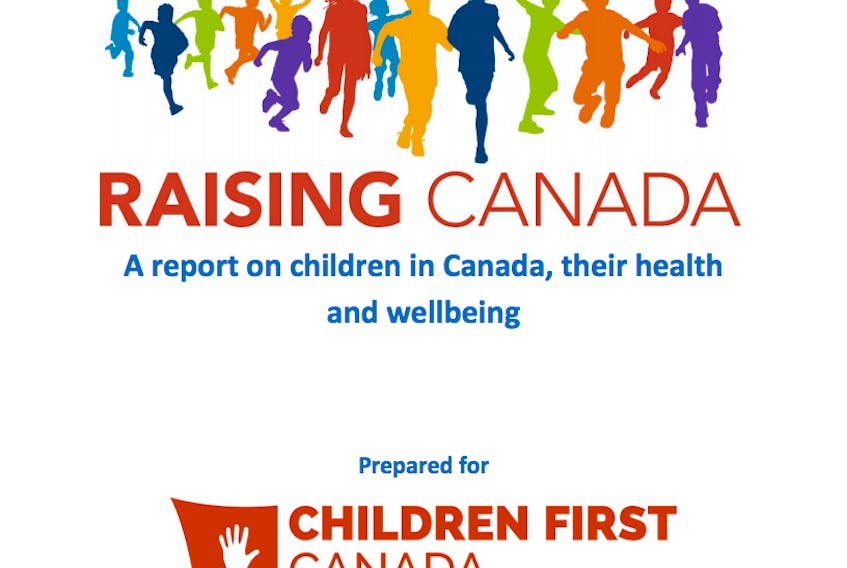A national study on the health of Canada’s children revealed that Newfoundland and Labrador tops all the provinces in the number of overweight or obese children ages 12 to 17.
The report found that 36.4 per cent of this province’s children in that age bracket were classified as overweight or obese compared to the national average of 27.9 per cent, based on Statistics Canada information. No information was available for the territories.
The study, called “Raising Canada,” was released Tuesday by Children First Canada and the O’Brien Institute for Public Health.
"In 2018, ParticipACTION released their report card on physical activity for children and youth. A greater percentage of younger children than older children meet the physical activity recommendation of the Canadian 24-Hour Movement Guidelines for Children and Youth, with 62 per cent of three- to four-year-olds and 35 per cent of five- to 17-year-olds meeting the guidelines,” the report states.
“This is a slight improvement from previous years.
“Between 1978-79 to 2004 (a period of 25 years), the prevalence of overweight and obesity in children and adolescents rose considerably, with the most substantial increases observed in economically developed countries. According to the results of the 2004 Canadian Community Health Survey: Nutrition (CCHS), Canadian youth are part of this trend. Amongst adolescents (12-17 years), the overweight/obesity rates more than doubled, and obesity rate tripled in this 25-year period, for a total of 26 per cent. These rates vary across the country, with the highest rates in the Atlantic provinces. These rates appear to have plateaued — in 2017, 27.9 per cent of children aged 12-17 reported being overweight or obese. This is a slight increase from 26.8 per cent in 2016.”
Another area in the report related to physical health stated that, nationally, 25 per cent of children had not received the full four recommended doses of diphtheria, whooping cough and tetanus vaccine by age two.
The report sounds alarm bells as classroom bells are about to ring as Canadian children return to school this week.
The study highlights statistics that require immediate action across the country, the report states, including action to deal with staggeringly high rates of mental health issues, poverty, obesity and mortality.
The study found that the leading causes for childhood deaths in Canada are preventable accidents and injuries, and suicide.
While Canada’s rate of infant mortality is among the highest of Organization for Economic Co-operation and Development (OECD) countries, Newfoundland and Labrador has the second-lowest rate of infant mortality (tied with Quebec), with 4.3 deaths per 1,000, according to Statistics Canada. Nunavut has the highest rate, with 17.7 — more than double any other province.
In relation to children’s mental health nationwide, there has been a 66 per cent increase in emergency department visits over the last 10 years and a 55 per cent increase in hospitalizations for (ages 5 to 24 years) due to mental health concerns.
In Newfoundland and Labrador, 562 children were hospitalized for mental health concerns in Newfoundland in 2016 to 2017, according to the Canadian Institute for Health Information.
The report also states that suicide is the second-leading cause of death for Canadian children and youth, and Canada is ranked in the top five countries for the highest child suicide rates globally.
Another distressing finding is that 1.2 million children live in low-income housing in Canada.
In this area, Newfoundland and Labrador is tied with Saskatchewan for the third-lowest number of children in low-income households (17.8 per cent), according to the 2016 census. It ranks much lower than all other Atlantic provinces. (Census did not include data from the territories).
Other statistics show that 10.7 per cent of families with children under six years of age say they experience food insecurity; one in three Canadians report having suffered some form of child abuse before the age of 16; 26 per cent experienced physical abuse; 10 per cent experienced sexual abuse; and eight per cent had exposure to intimate partner violence.
In 2013-14, 17,500 hospitalizations of children and youth in Canada were for injuries — 3,000 of which were intentional/caused by others.
“Many Canadians think this is one of the best countries in the world to raise a child, but the statistics prove otherwise,” said Sara Austin, founder and lead director of Children First Canada.
She noted Canada consistently ranks far behind most other affluent nations for the well-being of children, falling in 25th place according to UNICEF.
Austin said the report is a call to action for the federal government and provincial and municipal leaders — as well as all Canadians — to do more to invest in the health and well-being of Canada’s children.
Recommendations in the report include:
• The establishment of a national Commission for Children and Youth — an independent government office to promote the best interests of children and hold government accountable;
• The implementation of a children’s budget to track national investment in children, ensure the equitable distribution of resources, while ensuring funds are allocated toward evidence-based solutions for children;
• The full implementation of the UN Convention on the Rights of the Child and the Canadian Children’s Charter.
The Canadian Children’s Charter is a document drafted by Children First Canada with input from thousands of children and youth from across the country.
“It is both an economic and moral imperative that we act now, and we call on our government, and on all Canadians, to join us,” Austin said. “Our collective fate as a nation rests on the well-being of our children.”









